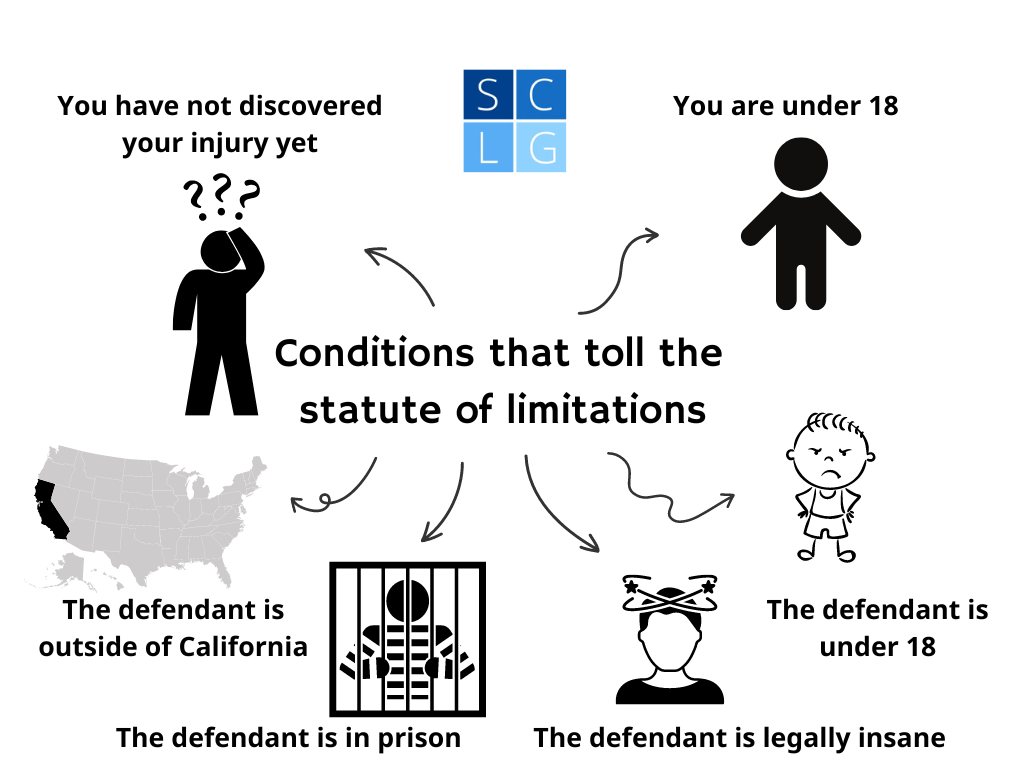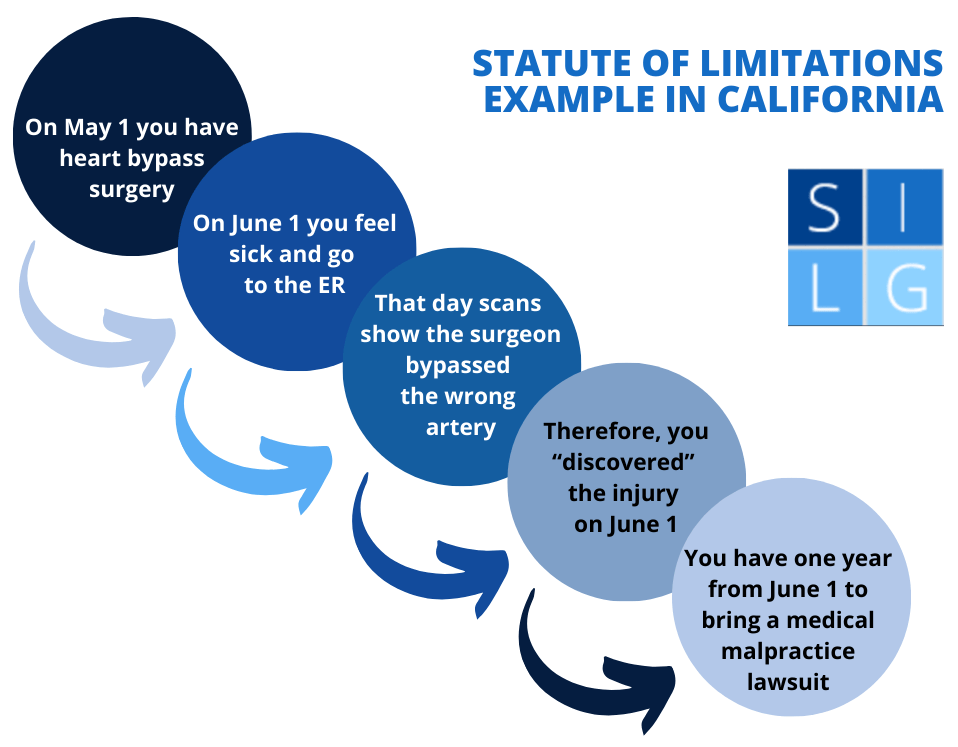California’s statute of limitations for personal injury lawsuits is usually two years after your accident. If you file after this deadline, the court will dismiss your case unless a legal exception caused your statute of limitations to “toll” (pause).1
Here are five things to know:
- The statute of limitation does not begin running until you discover your injury.
- If the defendant in your case is outside of California, the statute of limitation tolls until they return.
- In medical malpractice cases, you have only one year to sue after discovering your injury.
- Statutes of limitations encourage victims to sue quickly before memories and evidence fade.
- Statutes of limitations also protect people from having to defend against “stale” legal claims.2
In this article, our California personal injury attorneys discuss how statutes of limitations work with regard to:
- 1. The discovery rule
- 2. Tolling
- 3. Medical malpractice
- 4. Child victims
- 5. Suing the government
- 6. Other civil claims
- 7. Missed deadlines
- Additional reading
1. The discovery rule
Under California personal injury law, the statute of limitations does not begin running until you discover – or should have discovered – your injury (whichever happens first).
The reason behind the discovery rule is that there is often a time gap between when your accident happens and when your injury appears. You should not lose out on time to prepare your case while you are unaware of your injury.3
Example: On January 1, Mary gets rear-ended in Los Angeles. She feels fine, but on February 1 her doctor discovers soft-tissue damage caused by the car crash. Here, the two-year statute of limitations to bring a personal injury claim begins running on February 1 – the day she discovered her injury.

2. Tolling
Conditions that cause the statute of limitations to toll in California personal injury cases include the defendant (at-fault party) in your case being either:
- under 18 years old,
- outside the state of California,
- in state prison (not county jail), or
- legally insane.
The statute of limitations can resume if and when the condition leading to tolling has ended.4
In cases where you were the victim of a serious felony such as rape, kidnapping, or attempted murder, you have 10 years from the defendant’s discharge from parole to sue. For less serious felonies, you have a one-year period after the defendant’s judgment to bring a legal action.5
3. Medical malpractice
California medical malpractice claims generally must be filed by the earlier of:
- One year after the injury was discovered (or should have been discovered);6 or
- Three years after the injury occurred.7
For veterinary malpractice, the one-year statute of limitations starts running on the actual date of the injury.8

4. Child victims
If you were a minor when your accident occurred, the statute of limitations to sue usually does not begin running in California until you turn 18 – the age at which you gain the legal capacity to make decisions.9 Though there are exceptions:
If you were a child sex abuse victim, you may sue your abusers by the later of:
- your 40th birthday or
- five years after discovering the abuse.10
In medical malpractice claims, minor victims must file civil lawsuits within the later of:
- three years from the date of the alleged wrongful act, or
- if the minor is under six years old at the time of injury, prior to their eighth birthday.11
If the injury occurred prior or during birth, any lawsuit must be brought within six years of the birth.12

The time period for minors to sue turns on the type of case.
5. Suing the government
To sue a California government agency for negligence, you must bring an “administrative claim” within six months of the injury. The government entity has 45 days to respond:
- If the government denies your claim, you can bring a personal injury lawsuit against the government within six months of their denial.
- If the government fails to respond at all, you have two years from your injury (the standard statute of limitations) to sue the government.
A common claim against government agencies is that they were negligent in maintaining safe roads and clear signage, which contributed to your car accident.13
6. Other civil claims
The statute of limitations to sue for certain injuries in California can be longer or shorter than two years. Therefore, it is important you contact a personal injury attorney as soon as possible after your accident to determine your deadline to sue.
|
Injury type |
California statute of limitations (generally) |
|
90 days |
|
6 months |
|
1 year |
|
2 years |
|
3 years |
|
4 years |
|
6 years |
|
10 years |
|
When you turn 40 or 5 years after you discover the abuse (whichever is later)14 |
7. Missed deadlines
If the statute of limitations in your case passed in California, you still may have time to sue on other grounds with a longer statute of limitations.
Example: Kevin injures himself while painting Jack’s house because the deck was rotting. Kevin misses the two-year deadline to sue Jack for negligence. However, he still has two more years to sue for breaching their written contract where Jack promised to reasonably ensure Kevin’s safety. This is because breaching a written contract carries a four-year time limit to sue.
So even when one claim’s statute of limitations has run, there may be another viable claim that has a later deadline.

It takes a large amount of time to craft a winning case, so you should contact a personal injury law firm as soon as possible.
Additional reading
For more information, refer to our related articles by our California personal injury lawyers:
- 5 situations when the statute of limitations is tolled in California
- What is the limitations period for an injured person to sue for negligence in California?
- What is the medical malpractice statute of limitations under California law?
- What is the statute of limitations for wrongful death in California?
- “Delayed discovery rule” under California state law – How it works
Legal references:
- California Code of Civil Procedure §335.1. See, for example: Litwin v. Estate of Formela (, 2010) ; Bullard v. California State Automobile Assn., (, 2005) .
- See Jolly v. Eli Lilly (1988) 44 Cal.3d 1103.
- California Civil Jury Instructions (CACI) 455.
- See, for example, Brooks v. Mercy Hospital (Court of California, Fifth Appellate District, 2016) ; Alcott Rehab. Hosp. v. Superior Court () ; Shalabi v. City of Fontana () ; Arrow Highway Steel, Inc. v. Dubin () .
- CCP § 340.3.
- See CCP § 340.6.
- CCP 340.5.
- CCP § 340(c).
- CCP § 352(a)
- California Assembly Bill 218 (2019); California Code of Civil Procedure 340.1 & 1002; Patrick McGreevy, “California grants more time for filing child sexual abuse allegations under new law,” LA Times (Oct. 13, 2019).
- CCP § 340.5.
- CCP § 340.4.
- CCP § 341. Statute of Limitations, California Courts.
- CCP §340.2(a). CCP §341a. CCP Title 2.
